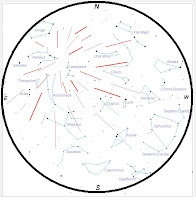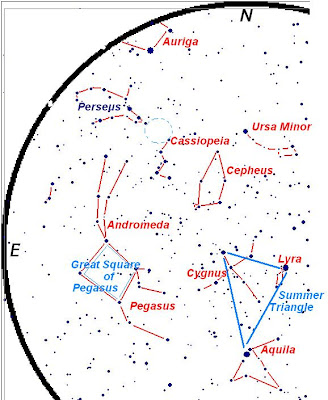.....Each time a comet passes through the inner solar system, if it still has much of its original ice, that ice will boil off, taking some dust pebbles with it, and the ice will reflect sunlight, resulting in
 the bright coma and tail. What happens to this once the comet goes back to the outer reaches of the solar system? Nothing. That comet rubble stays in orbit, resulting in the comet's orbit eventually becoming a dusty tube of gunk around the Sun. If the Earth should pass through this gunk, then when the particles hit the Earth's atmosphere they will light up from the heat of friction generated from going from a temperature of less than three hundred degrees below zero (Fahrenheit) to thousands of degrees. Since all of these meteors are coming from the same general area in space, they will appear to come from the same general area of the sky, meaning that the meteors will all seem to radiate out from the same point. (Called, reasonably enough, the "radiant".)
the bright coma and tail. What happens to this once the comet goes back to the outer reaches of the solar system? Nothing. That comet rubble stays in orbit, resulting in the comet's orbit eventually becoming a dusty tube of gunk around the Sun. If the Earth should pass through this gunk, then when the particles hit the Earth's atmosphere they will light up from the heat of friction generated from going from a temperature of less than three hundred degrees below zero (Fahrenheit) to thousands of degrees. Since all of these meteors are coming from the same general area in space, they will appear to come from the same general area of the sky, meaning that the meteors will all seem to radiate out from the same point. (Called, reasonably enough, the "radiant".).....Each August, the Earth passes through the remnant trail of the comet Swift-Tuttle, generating the Perseid meteor shower because the radiant of the meteors (the dotted circle in the image below) is in the constellation of Perseus.
.....The Perseid meteor shower does not require a telescope or binoculars; just go outside (especially on the nights of Wednesday, August 11th and Thursday, August 12th, and look to the northeast (especially after midnight).
.....Of the the backyard astronomy I have done, I have a special regard for the Perseid Meteor Shower. Because it does not require special equipment, special practice or special skills, it is easy to share with others. (Also, since observing the Persieds is just looking at the sky, there is no "one person at a time effect that you get with a telescope.) Last year, one of my friends told me about taking his son outside to see the meteors. I've gotten other mail about people who have had their parents show them the meteor shower, and have then shared it with their children. For me, the Perseids were one event I could most easily drag people out to see, often going to visit family with dark skies, or just setting up lawn chairs behind the house, or (one time) my parents even took us to a state park to watch the meteors. For me this gives the Perseids a fairly personal level, especially since my father passed away two and a half years ago. When I would have my telescope at home, it would always be easiest to interest my Dad in coming out and looking at the sky, so there were a lot of times he (and others) would come out, but the Perseids could get everyone out, so its something of a family holiday in my book. I hope that you have the opportunity (weather) to give it a try this year. There will be no bright moonlight those nights, so the sky should be quite dark.

.....Here is a map of the northeastern part of the sky on Thursday at about midnight. Please let me know if you have traditions about the Perseids, or if you have a chance to observe them! If you are in the Winona, Minnesota area, there will be a public observing session at Saint Mary's University of Minnesota. Turn in at the lower gate (across from Goodview Road) and drive straight (i.e., don't make any turns) to St. Yon's Hall. We will set up on the field next to St. Yon's. Bring your own chair/blanket/keep-my-rear-end-dry-device!

Cool Article, thanks for the info!
ReplyDelete